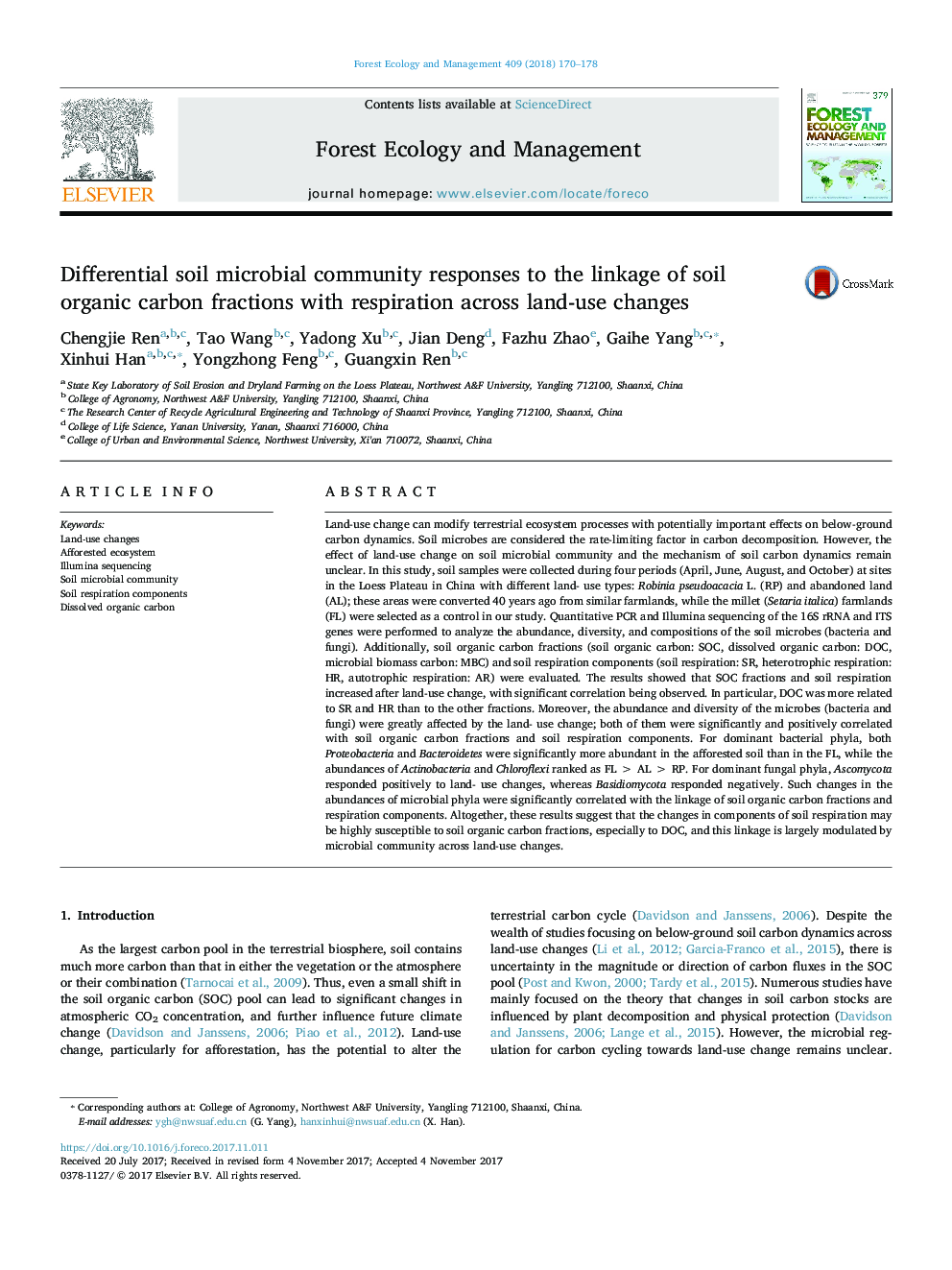| کد مقاله | کد نشریه | سال انتشار | مقاله انگلیسی | نسخه تمام متن |
|---|---|---|---|---|
| 6541880 | 1421349 | 2018 | 9 صفحه PDF | دانلود رایگان |
عنوان انگلیسی مقاله ISI
Differential soil microbial community responses to the linkage of soil organic carbon fractions with respiration across land-use changes
ترجمه فارسی عنوان
واکنش های جامعه متقابل میکروبی خاک به پیوند بخش های کربن آلی خاک با تنفس در تغییرات استفاده از زمین است
دانلود مقاله + سفارش ترجمه
دانلود مقاله ISI انگلیسی
رایگان برای ایرانیان
کلمات کلیدی
موضوعات مرتبط
علوم زیستی و بیوفناوری
علوم کشاورزی و بیولوژیک
بوم شناسی، تکامل، رفتار و سامانه شناسی
چکیده انگلیسی
Land-use change can modify terrestrial ecosystem processes with potentially important effects on below-ground carbon dynamics. Soil microbes are considered the rate-limiting factor in carbon decomposition. However, the effect of land-use change on soil microbial community and the mechanism of soil carbon dynamics remain unclear. In this study, soil samples were collected during four periods (April, June, August, and October) at sites in the Loess Plateau in China with different land- use types: Robinia pseudoacacia L. (RP) and abandoned land (AL); these areas were converted 40 years ago from similar farmlands, while the millet (Setaria italica) farmlands (FL) were selected as a control in our study. Quantitative PCR and Illumina sequencing of the 16S rRNA and ITS genes were performed to analyze the abundance, diversity, and compositions of the soil microbes (bacteria and fungi). Additionally, soil organic carbon fractions (soil organic carbon: SOC, dissolved organic carbon: DOC, microbial biomass carbon: MBC) and soil respiration components (soil respiration: SR, heterotrophic respiration: HR, autotrophic respiration: AR) were evaluated. The results showed that SOC fractions and soil respiration increased after land-use change, with significant correlation being observed. In particular, DOC was more related to SR and HR than to the other fractions. Moreover, the abundance and diversity of the microbes (bacteria and fungi) were greatly affected by the land- use change; both of them were significantly and positively correlated with soil organic carbon fractions and soil respiration components. For dominant bacterial phyla, both Proteobacteria and Bacteroidetes were significantly more abundant in the afforested soil than in the FL, while the abundances of Actinobacteria and Chloroflexi ranked as FLâ¯>â¯ALâ¯>â¯RP. For dominant fungal phyla, Ascomycota responded positively to land- use changes, whereas Basidiomycota responded negatively. Such changes in the abundances of microbial phyla were significantly correlated with the linkage of soil organic carbon fractions and respiration components. Altogether, these results suggest that the changes in components of soil respiration may be highly susceptible to soil organic carbon fractions, especially to DOC, and this linkage is largely modulated by microbial community across land-use changes.
ناشر
Database: Elsevier - ScienceDirect (ساینس دایرکت)
Journal: Forest Ecology and Management - Volume 409, 1 February 2018, Pages 170-178
Journal: Forest Ecology and Management - Volume 409, 1 February 2018, Pages 170-178
نویسندگان
Chengjie Ren, Tao Wang, Yadong Xu, Jian Deng, Fazhu Zhao, Gaihe Yang, Xinhui Han, Yongzhong Feng, Guangxin Ren,
